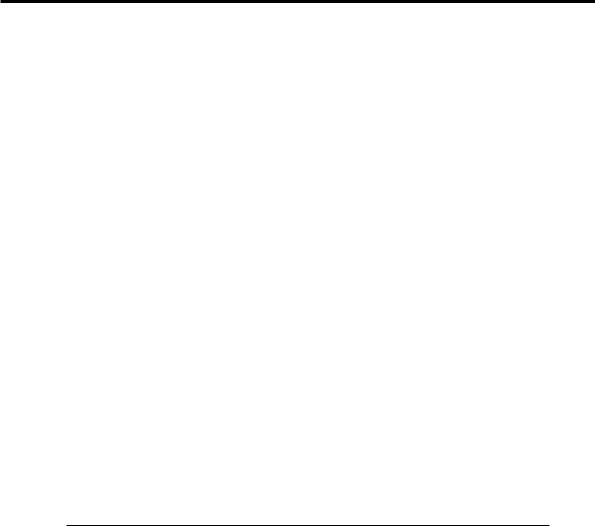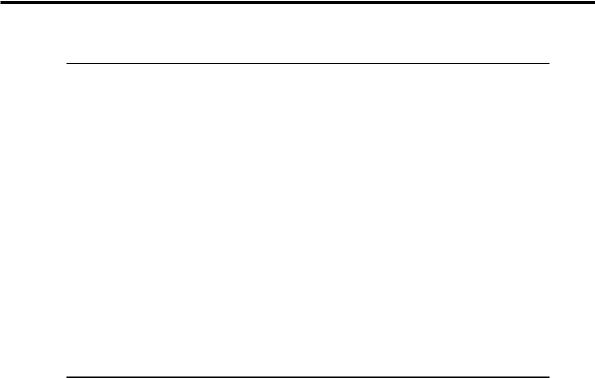
Interfacing with C plus plus-programing communication with microcontrolers (K. Bentley, 2006)
.pdf
8 DRIVING MOTORS - DC & STEPPER 235
while(!kbhit()) MotorPtr->Reverse(); getch();
MotorPtr->SetSpeed(255); while(!kbhit()) MotorPtr->Reverse(); getch();
cout << endl << " Braking Applied!" << endl; while(!kbhit()) MotorPtr->Brake();
getch();
MotorPtr->Off();
//..... Motor control part ends here .....
The user must be given a list of motor types to be able to choose a motor to operate. The code to implement this task is given in Listing 8-11.
Listing 8-11 Statements to display a menu of Motors on the screen.
int Selection;
clrscr(); |
|
|
|
cout << endl << " |
MOTOR MENU"; |
||
cout << endl << " |
~~~~~~~~~~" << endl; |
||
cout << " |
1 |
DC Motor" << endl; |
|
cout << " |
2 |
UPFS" << endl; |
|
cout << " |
3 |
UPHS" << endl; |
|
cout << " |
4 |
BPFS" << endl; |
|
cout << " |
5 |
BPHS" << endl; |
|
cout << " |
6 |
QUIT" << endl; |
|
cout << endl; |
|
|
|
cout << " |
Select the MOTOR Number: "; |
||
cin >> Selection;
Having selected the motor, we need to use dynamic memory allocation to create the object type that corresponds to the motor selected. Listing 8-12 shows the dynamic memory allocation segment of the program.
Listing 8-12 Dynamic memory allocation for the selected Motor.
switch(Selection)
{

236 8 DRIVING MOTORS - DC & STEPPER
case 1: MotorPtr = new DCMotor; break;
case 2: MotorPtr = new StepperMotor(UPFS); break;
case 3: MotorPtr = new StepperMotor(UPHS); break;
case 4: MotorPtr = new StepperMotor(BPFS); break;
case 5: MotorPtr = new StepperMotor(BPHS); break;
case 6: return;
default: cout << endl;
cout << " Unspecified Motor type...."; cout << " PRESS a key to END Program!"; getch();
exit(1); // Exits the program
}
if(MotorPtr == NULL)
{
cout << "Memory allocation failed " << endl; getch();
exit(1);
}
At the end of this program segment, the pointer MotorPtr should be initialised to point to a valid object in memory. If not, the program will exit because a matching motor type could not be found, or memory allocation has failed. Once the pointer is initialised, the program segment given in Listing 8-10 can be executed. The complete main() function is given in Listing 8-13.
Listing 8-13 The main() function to control 'a Motor'.
void main()
{
Motor *MotorPtr; int Selection;
clrscr();
cout << endl << " MOTOR MENU";
cout << endl << " ~~~~~~~~~~" << endl; cout << " 1 DC Motor" << endl;

8 DRIVING MOTORS - DC & STEPPER 237
cout << " |
2 |
UPFS" << endl; |
cout << " |
3 |
UPHS" << endl; |
cout << " |
4 |
BPFS" << endl; |
cout << " |
5 |
BPHS" << endl; |
cout << " |
6 |
QUIT" << endl; |
cout << endl; |
|
|
cout << " |
Select the MOTOR Number: "; |
|
cin >> Selection;
switch(Selection)
{
case 1: MotorPtr = new DCMotor; break;
case 2: MotorPtr = new StepperMotor(UPFS); break;
case 3: MotorPtr = new StepperMotor(UPHS); break;
case 4: MotorPtr = new StepperMotor(BPFS); break;
case 5: MotorPtr = new StepperMotor(BPHS); break;
case 6: return;
default: cout << endl;
cout << " Unspecified Motor type...."; cout << " PRESS a key to END Program!"; getch();
exit(1); // Exits the program
}
if(MotorPtr == NULL)
{
cout << "Memory allocation failed " << endl; getch();
exit(1);
}
cout << "**********************************" << endl; cout << "* CONNECT BOARD POWER SUPPLY NOW *" << endl;
cout << "**********************************" << endl; cout << endl;
cout << " After connecting power,”;
cout << “ press a key to continue " << endl; getch();

238 8 DRIVING MOTORS - DC & STEPPER
cout << " Keypress changes Speed/Rotation (& Braking)." << endl;
//..... Motor control part starts here .....
MotorPtr->SetSpeed(150); while(!kbhit()) MotorPtr->Forward(); getch(); // clear keyboard buffer
MotorPtr->SetSpeed(255); while(!kbhit()) MotorPtr->Forward(); getch();
MotorPtr->SetSpeed(150); while(!kbhit()) MotorPtr->Reverse(); getch();
MotorPtr->SetSpeed(255); while(!kbhit()) MotorPtr->Reverse(); getch();
cout << endl << " Braking Applied!" << endl; while(!kbhit()) MotorPtr->Brake();
getch();
MotorPtr->Off();
//..... Motor control part ends here .....
// Free the memory occupied by the 'Motor' object delete MotorPtr;
}
The compiler should have seen the definition of the entire class hierarchy and the definition of all member functions when it comes time to compile the main() function in Listing 8-13. We will defer explaining the complete program until virtual destructors have been discussed.
8.6.1 Virtual Destructors
The destructor of the class is called indirectly whenever the delete operator is used on an object of the class as discussed in Section 5.3.8. Since we have not declared any destructors in our motor class hierarchy, the only destructors available to our classes are the default destructors generated by the compiler for each class in the hierarchy. The selected motor has a corresponding ‘motor’ object instantiated in the body of the program’s switch statement (Listing 8-13). When the program is finished using the ‘motor’ object, it frees the memory occupied by the ‘motor’ object using the following statement:

8 DRIVING MOTORS - DC & STEPPER 239
delete MotorPtr;
Since MotorPtr is a pointer to the abstract base class Motor, the previous statement will call the default destructor of the Motor class and will only deallocate the space occupied by a Motor class object. The delete statement will not free the memory space occupied by the actual object in use (such as DCMotor), thereby generating a memory leak. We can demonstrate this event using an example program that has a simple class structure and a simple main() function as shown in Listing 8-14. Note: to further simplify the example, the Base and Derived classes do not have data members. We have also included cout statements within the body of the two destructors to show when each destructor is called. If the destructors did not have these cout statements, they would be identical to the default destructors generated by the compiler.
Listing 8-14 Use of non-virtual destructors.
#include <conio.h> #include <iostream.h>
class Base
{
public:
Base(){}
~Base()
{
cout << "Base type object deleted" << endl;
}
};
class Derived : public Base
{
public:
Derived(){};
~Derived()
{
cout << "Derived type object deleted " << endl;
}
};
void main()
{
Base *BasePtr;
BasePtr = new Derived; // BasePtr points to an object // of type Derived.

240 8 DRIVING MOTORS - DC & STEPPER
delete BasePtr; |
// Deletes object |
}
The pointer identifier BasePtr is declared to be of type Base. However, it is used to point to a dynamically allocated class object that is of type Derived. We use the following statement with the intention of deleting the dynamically allocated object of class Derived:
delete BasePtr;
We would expect this statement to call the destructor of the derived class. However, the following message is displayed when this program is executed:
Base type object deleted
This indicates that the destructor of the Derived class has not been called as intended to destroy the dynamically allocated Derived type object. We change the program to operate correctly by making the destructor ~Base() virtual. The modified program listing is shown in Listing 8-15.
Listing 8-15 Use of virtual destructors.
#include <conio.h> #include <iostream.h>
class Base
{
public:
Base(){} virtual ~Base()
{
cout << "Base type object deleted" << endl;
}
};
class Derived : public Base
{
public:
Derived(){};
~Derived()
{
cout << "Derived type object deleted " << endl;
}
};
void main()

8 DRIVING MOTORS - DC & STEPPER 241
{
Base *BasePtr; |
|
|
BasePtr = new Derived; |
// BasePtr |
points to an object |
|
// of type Derived. |
|
delete BasePtr; // Deletes object |
|
|
}
Note that in Listing 8-15 the keyword virtual is added in front of the destructor name ~Base(). This provides the link to all virtual destructors down to the next level of the class hierarchy so the correct destructors will be called. If you run this program you will see the following printed on the screen:
Derived type object deleted
Base type object deleted
This demonstrates that the delete statement has called the Derived class destructor and the Base class destructor, properly relinquishing the memory allocated for the Derived and Base class objects. Note: when an object of a derived class is instantiated, the constructor function of the base class is called first followed by a call to the constructor of the derived class. The derived class inherits the members of the base class that are instantiated in this manner. Therefore, it is important to include virtual destructors so that any memory allocation from within the derived class and its base class is properly relinquished.
Now we can return our attention to the motor control program. To allow the delete statements to properly de-allocate the dynamically allocated objects, we must provide a set of destructors; one destructor for each class of the motor class hierarchy, and we must make them virtual destructors. The bodies of these destructors can be empty. We simply need to establish a network of virtual destructors throughout the class hierarchy so that proper late binding will take place for the destructors. The modified class definitions are given in Listing 8-16 through to Listing 8-18.
C++ |
Virtual Destructor Names |
|
|
In a class hierarchy all virtual functions must have the same function signature;
i.e. they must have the same function name, same number of formal arguments
and the same types of formal arguments in each virtual function. However,
virtual destructors have different names throughout the hierarchy. Despite
having different destructor function signatures, late binding will enable the
correct set of destructors to be deployed in response to a delete statement.

242 8 DRIVING MOTORS - DC & STEPPER
Listing 8-16 AbstractMotor class with virtual destructor.
class AbstractMotor
{
private:
int Speed;
public:
AbstractMotor();
void SetSpeed(int speed); int GetSpeed();
virtual void Off()=0; virtual void Forward()=0; virtual void Reverse()=0; virtual void Brake()=0; virtual ~AbstractMotor(){}
};
Listing 8-17 ParallelPort class with virtual destructor.
class ParallelPort
{
private:
unsigned int BaseAddress; unsigned char InDataPort1;
public:
ParallelPort(); ParallelPort(int baseaddress);
void WritePort0(unsigned char data); void WritePort2(unsigned char data); unsigned char ReadPort1();
virtual ~ParallelPort(){}
};
Listing 8-18 Motor class with virtual destructor.
class Motor : public AbstractMotor, public ParallelPort
{
public:
Motor(int baseaddress=0x378); void Off();
virtual void Forward()=0;

8 DRIVING MOTORS - DC & STEPPER 243
virtual void Reverse()=0; virtual void Brake()=0; virtual ~Motor(){}
};
Now that we have proper destructors in our classes, we can write a complete program using virtual functions to control a motor and free memory as intended. Such a program is shown in Listing 8-19. Note that virtual destructors are not added to the DCMotor class or the StepperMotor class since these two classes are the terminal classes of the hierarchy. However, the program would still function properly if virtual destructors had been added to these two classes.
NOTE
Ensure the interface board is unpowered before connecting any type of motor. This needs to be done for the following reason.
Before first running the program, the port controlling the motor will not be under
control of the program and may be in an unknown state. This unknown state can
be such that the port’s logic states would drive the transistors to short-circuit the
motor’s power supply (damaging the transistors and possibly the power supply).
The program instructs the user to apply power to the board once it has set these
bits to a safe state. When the program ends, it sets the used bits of the port to a safe state to prevent any damage to the transistors or the power supply.
Connect a DC motor to the interface board as given in Table 8-7 and Table 8-9.
Stepper motors are connected to the interface board as shown in Figure 8-25 and
Figure 8-26.
If the motor does not drive as expected, first check for incorrect connections.
Listing 8-19 Complete program to control 'a Motor' using Virtual Functions.
//**************************************************
//Program to operate a Motor using Virtual Functions.
//**************************************************
#include <dos.h> #include <conio.h> #include <stdio.h> #include <stdlib.h> #include <iostream.h>
class ParallelPort
{
private:

244 8 DRIVING MOTORS - DC & STEPPER
unsigned int BaseAddress; unsigned char InDataPort1;
public:
ParallelPort(); ParallelPort(int baseaddress);
void WritePort0(unsigned char data); void WritePort2(unsigned char data); unsigned char ReadPort1();
virtual ~ParallelPort(){}
};
ParallelPort::ParallelPort()
{
BaseAddress = 0x378; InDataPort1 = 0;
}
ParallelPort::ParallelPort(int baseaddress)
{
BaseAddress = baseaddress; InDataPort1 = 0;
}
void ParallelPort::WritePort0(unsigned char data)
{
outportb(BaseAddress,data);
}
void ParallelPort::WritePort2(unsigned char data)
{
outportb(BaseAddress+2,data ^ 0x0B);
}
unsigned char ParallelPort::ReadPort1()
{
InDataPort1 = inportb(BaseAddress+1);
//Inverting Most significant bit to compensate
//for internal inversion by printer port hardware. InDataPort1 ^= 0x80;
//Filter to clear unused data bits D0, D1 and D2 to zero. InDataPort1 &= 0xF8;
return InDataPort1;
}
